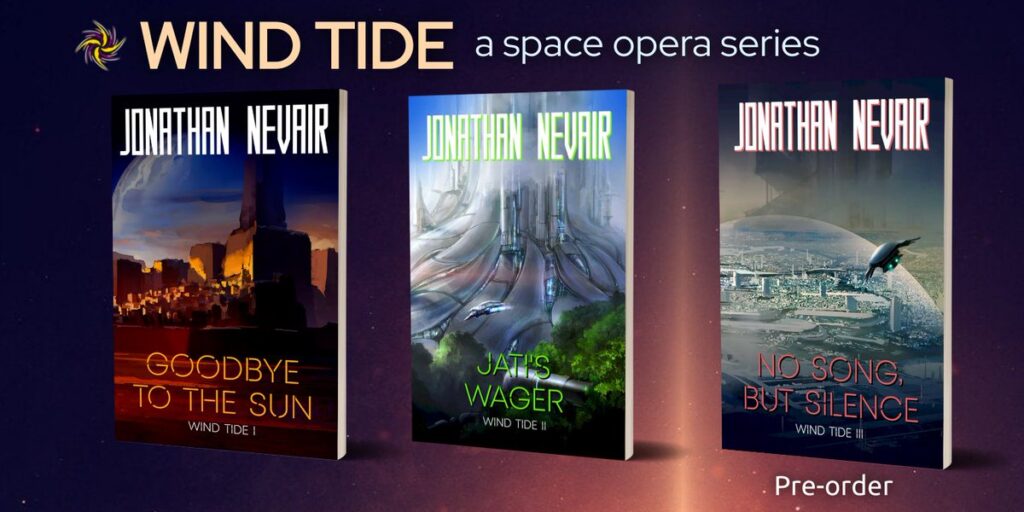Pg. 12
An Interview with Author Jonathan Nevair by Jean-Paul L. Garnier

Jonathan Nevair

Garnier: You debuted as an author with a trilogy, three books released in one year. This is unusual for a space opera series. What made you decide to do the releases this way and what were the advantages and difficulties along the way?
Nevair: The one-year release schedule for the Wind Tide trilogy was the publisher’s idea. We backloaded the novels on the publishing calendar for 2022. Goodbye to the Sun rested while I wrote the second book, Jati’s Wager. Then, as we neared the release of Goodbye to the Sun, I began writing the third book, No Song, But Silence. We turned that last one around quickly and kept the release cycle to three-month intervals in May, August, and November, respectively.
This approach offered the advantage of readers accessing the full series out of the publishing gate without waiting multiple years for subsequent books to release. As a writer, I found this backloading strategy advantageous for consistency and connections in narrative across the three books. Many times, while writing the trilogy, I went back into earlier books to make revisions/tweaks as new plot lines and other important world building information arose during the writing process. Probably most satisfying was the ability to revise and craft stronger foreshadowing – I would have lost out on this opportunity if the books were released on an annual cycle.
On the other hand, the schedule crunch did weigh on me in making the deadline for No Song, But Silence. The pressure was on because the marketing phase for the trilogy was already underway when that final book was being written. I like to stew in between writing novels, allowing the most recent manuscript to settle like ripples spreading and diminishing from a rock thrown into still water. Since the Wind Tide is an anthology series, I wasn’t picking up the same story exactly where it left off and with the same characters. Time to digest is important to my process, and I didn’t have the usual timeframe before embarking on No Song, But Silence that I had with Goodbye to the Sun and Jati’s Wager. I’d do the backload strategy again, but six-month intervals would provide a better balance between author/reader needs and market expectations.
Garnier: What caused you to gravitate towards writing space opera, and will you continue along this path or will you be branching out into other sub-genres, and if so why?
Nevair: Space opera appealed to me for two reasons. First, I enjoy creating vast secondary worlds and space opera offers the ability to manufacture a story at a galactic scale. That literary architecture is like inhabiting a massive design complex. It allows for world building of multiple cultures, societies, and political systems that can exist in conflict or harmony (something I very much enjoy enacting in my books – juxtaposing macro/micro conflicts where a cultural perspective and its misconceptions butt up against individual characters’ subjective experiences in or through these environments.
Space opera offers the means to invent and describe a diverse range of settings – planets, space stations, etc., and with space travel technologies moving locations across great distances is accomplished with relative ease (well, maybe not ease of relativity – sorry, could not resist).
Second, I relish science fiction settings that incorporate advanced tech situated in gritty and visceral natural worlds – like the Star War Universe, or even Dune, etc. Designing and describing planetary and biosphere ecologies are central for me in world building. As a writer, I’ve always envisioned secondary worlds as combining intimate sensory experiences of a natural biological ecosystems with the intellectual/experiential capabilities of futuristic technologies. I’m smitten with space opera and will most likely continue to write in that subgenre, though I do have a strong desire to write a science fantasy down the road.
Garnier: In the Wind Tide Trilogy you state that the stories were influenced by Greek myths, how have you integrated these ideas into your fiction?
Nevair: Each book in the Wind Tide trilogy is inspired by Ancient Greek texts and myths, but none function as strict futuristic retellings or reinterpretations. The themes, plot, and characters in Greek literary works such as Antigone, or the descriptions and myths of The Sack of Troy and the famous Trojan Horse in Homer’s Iliad, as well as the play by Aeschylus, The Eumenides, are each transported to a far-future space opera to be born anew through abstracted versions of the original characters, actions, and themes. Structurally, I did incorporate specific plot points from narrative forms such as Greek tragedy, especially the Aristotelian concepts of hamartia and peripeteia.
Antigone’s emphasis on the struggle between family and state fit with the moral problems at the heart of Goodbye to the Sun, especially the themes of terraforming and energy competition on a planet with a fractured indigenous culture and colonial presence. From there, the other two came easy: a heist (Jati’s Wager)? The Trojan Horse, of course. And No Song, But Silence? A tale of moral transformation and a new code of justice led me to The Eumenides.
It’s challenging to approach pre-existing sources critically while allowing your creativity to lead the writing process. I believe it is the responsibility of contemporary science fiction to re-envision and re-interpret historical influences in creative ways that update, critique, and break the social and cultural limitations of the original versions. I endeavored to carry out that mission in the Wind Tide series.
Garnier: One of the strengths I find in your writing is your ability to create a rich implied history, how do you go about this, and do you have any advice for writers concerning this technique?
Nevair: Early on (this could be before the actual book is written or after a few chapters or early notes are formed), I try to step back and write around, and before and after, the story itself with broad strokes. I’ll create a historical trajectory of the secondary world from 100,000 feet.
This creates a larger timeline to drop your specific book’s story into – for me, this meant inventing a series of epochs in the Wind Tide Universe. The three novels making up the trilogy take place near the end of the Third Span, their term for epoch, near the cusp of a Fourth Span looming over a future horizon. I had to imagine how world views and various zeitgeists rose and fell (or returned as revivals) over time. With a larger timeline outlined, the three books fell into place at the most effective locations for their plot lines and character arcs to fulfill the overall narrative goals in the trilogy.
Is this extra work? For me, it was a pre-writing labor of love with a massive payoff. I was able to bring this bird’s eye history down to ground level as I wrote by having characters reference (either specifically or in passing) events in their recent or distant pasts. The approach ensured a degree of historical and chronological consistency and served as a wonderful tool for world building, going a long way to a create a believable and memorable epic universe for three novels. It has the additional benefit of leaving a future playground readily crafted and waiting to be inhabited by more stories in the form of future books.
If you try this approach in your own writing, my advice is to gauge how much of the historical imaginative is for you as a world building exercise and preparation for writing the novel proper and how much of it needs to be inserted into the story you write for your readers. There’s lots of delicious information I wanted desperately to share that I had to keep out of the books because it provided too much exposition and didn’t serve the story and/or move the plot forward (if only novels had bonus features like movies . . . ). That said, I try and pull references from these broader historical strokes into the books through the dialog and actions of characters to make the secondary world come to life in the minds of readers (for example, references to wars, or a famous leader/event, a cultural practice no longer active, a philosophy or religion that has evolved or transformed into something else as part of a cultural shift or revolution, etc.) – to do that well means finding where “just enough” and not “too much” is, so the reference will blossom within readers’ imaginations, giving them the creative agency to become active producers in their imaginations.
Garnier: You’re an art historian by profession, how has teaching and this area of expertise affected your writing and plot structures?
Nevair: For certain, academic research and writing, and preparing discussions into cogent, coherent (and evidence-based) lecture content has been a great asset for writing novel-length fiction. Most interesting to me is the connection between world building and my work as an art history lecturer and educator. I’ve spent twenty years teaching and speaking publicly about visual art, using words to describe and celebrate visual images. That process of transcribing is also at work in fiction writing. The only difference is that much of the source material comes from my imagination without evidence-based restrictions (it starts as mental images). The practice of employing an economy of words and description as a lecturer, as well as understanding how to bring people into a work of art (with enthusiasm!), is something that works well when transcribed into science fiction writing. Similar to the way that iconography and a variety of cultural languages exist through body gesture, pose, and symbolic objects, etc. in works of art, when I world build in fiction, I try to achieve that same richness and degree of audience appreciation – and that goes for all the senses. I tend to write for mood when it comes to science fiction. I am after the feeling a situation or setting evokes for the characters in a story.
Garnier: Aside from novels you have also written some short fiction, how do these processes differ for you, and what do you find to be the strengths and weaknesses of each format?
Nevair: Short fiction is an exciting literary form, and quite new to me as a writer. I am enjoying it alongside book-length fiction writing. Both are unique and contain their own literary merits. Short and flash fiction formats offer an interesting exercise in brevity and have a distinct flavor that hits like a first-round KO in a boxing match or the way you view the world through a telescope or microscope. It puts a subject or situation into sharp and myopic focus, independent of what surrounds it because the subject of observation is itself enough to hold your attention and function autonomously. If done well, it offers a unique satisfaction as a reading experience. I appreciate the way that flash fiction can leave things narratively open, so long as a tease or a story’s allure doesn’t overshadow some semblance of a resolution. That’s fun and outside the boundaries of what is required in book-length fiction. The latter allows for a long build, which I love for the world building and character arcs, but short stories are very liberating exercises that don’t let you hide behind literary components common in novels. Starting fiction in media res is common, but I’m intrigued by the way short and flash fiction can end in media res while still making sure the reader walks away feeling grounded and satisfied.
Garnier: What’s next for you, and what are you currently working on?
Nevair: Goodbye to the Sun, the first book of the Wind Tide series, is in audiobook production and releases in mid-May. Listening to the narrators who auditioned for the book was a thrill. I am excited to announce that Skyler Morgan was selected as the best match for the book’s tone and central characters. He nailed the exchanges between Razor and Keen and his voice has a gravitas fitting the tone of the Wind Tide universe. I’m planning to have Skyler narrate all three books in the series, releasing them in short order over the next year.
In terms of future projects, my standalone spy-fi space opera, Stellar Instinct, releases in November 2022. It’s a classic secret agent plotline (nods to Cold-War era espionage books and films) meets a space opera setting. It has been loads of fun to play with these two subgenres as a literary mash-up. The main character, Lilline Renault, is a veteran secret agent and amateur poet, who faces down a gaming mastermind with designs to turn entertainment into real life. It’s character-driven but includes all the classic spy tropes. The main character’s poetry subplot is an interesting creative extension to the story, too. I’ve become rather obsessed with poetic meter, feet, etc. The book’s layout will include an appendix with Lilline’s poems referenced throughout the story as a separate readable collection at the end.
After Stellar Instinct is edited and wrapped up for release, I’m eyeing a science fantasy series. I’ve had an idea based on the philosophy of sleeping (inspired partly by Surrealism) floating around and I think it’s time to get it down on paper.
